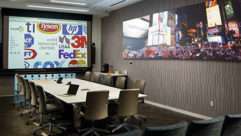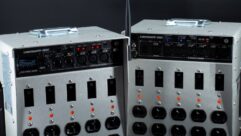
AptoVision: Behind the Chipset
Aug 26, 2014 9:02 PM,
With Bennett Liles
Listen to the Podcast

Editor’s note: For your convenience, this transcription of the podcast includes timestamps. If you are listening to the podcast and reading its accompanying transcription, you can use the timestamps to jump to any part of the audio podcast by simply dragging the slider on the podcast to the time indicated in the transcription.
From Sound & Video Contractor Magazine, this is the SVC Podcast with Kamran Ahmed of AptoVision. Show notes for the podcast can be found on the website of Sound & Video Contractor Magazine at svconline.com.
Up until recently, the big problem for HD and ultra-HD was making it go the distance. Any real distance. But some very elegant solutions have come in and one of them is from AptoVision. Kamran Ahmed is here to tell us about BlueRiver technology and what it means for HD video, multi-channel sound and lots more. That’s coming up next on the SVC Podcast.
Kamran, thanks for being with us on the SVC Podcast from AptoVision in Montreal. You guys were at Infocomm and you drew a very good crowd. What you brought to the show was something new in signal distribution and extension. Before we get into the technical details, tell us about AptoVision. The company itself isn’t that new. You’ve been around for a little while now.
Yes. So first thank you, Bennett, for having me on board. AptoVision was founded about three and a half years ago and we develop chipsets for AV signal distribution and processing platforms. Since our launch we’ve successfully delivered four different technologies, but essentially what our chipsets do is they distribute uncompressed video along with audio and all of the control signals such as RS232, IR over fiber cabling or copper cabling to solve the distance issue. And then these signals can be switched through circuit switches or off-the-shelf 10 gigabit Ethernet switches. And in our latest product offering we’re able to composite multiple videos onto one surface too. So we’re developing core chipsets that allow you to extend, switch and composite uncompressed video to solve the needs of the AV signal distribution market. [Timestamp: 2:03]
And a lot of things in that are changing. That area of technology is sort of the Wild West right now. Different companies are taking their own approaches to it. Is the AptoVision solution aimed primarily at large-scale signal distribution rather than point-to-point transmission or are you competing in that space too?
No. We’re competing in both areas. In fact, our first two generations of technology were focused on point-to-point extension and point-to-point with circuit-switching technology. Our latest technologies are focused on large-scale signal distribution. So we’re competing in both markets, but one of the main things we’re doing with our technology is developing a single platform that can really scale from a very small install that only requires point-to-point or two-by-two matrix switching, or it can scale up to thousands of inputs and output ports by leveraging networking technology which, as you know, is very scalable. [Timestamp: 3:00]
Okay, so that really broadens the spectrum of possible applications on this.
Absolutely.
With the capabilities of your chipsets, one key area might be digital signage?
Yes. Digital signage, professional audio/video requirements be it in airports, malls, convention centers – so pretty much everything that’s nonresidential. If you’re in commercial facilities, military, government facilities, large format displays are being used to communicate all kinds of information whether it’s advertising, whether it’s way finding, or just general information. So the market is for moving information onto a distal medium. It’s changing fast and that trend is growing. This creates problems in terms of how do you get content to the display which may be 20 or 30 feet high up in the air, because normally HDMI cables and USB cables are not designed for more than 20-30 feet. So the technologies designed for AV signal distribution primarily solve the distance issue and then the distribution issue, which means okay, once you have the signal that can travel long distances most likely it will also have to be distributed to numerous displays across a facility. So I always like to describe the problem as how do you take water from a water tank into the taps. The taps are the displays, the water tank is where the content is coming from, and then all your plumbing in the middle is needed to get the water to the taps. The AV signal distribution is like the plumbing in the facility to distribute water. [Timestamp: 4:37]
And a lot of what we see in that area now involves proprietary systems where you’re with one manufacturer and you go their way with all the components or you don’t go. Now you’ve talked about this on the show floor but just so we’re clear on the basic difference. How do you define circuit switches as opposed to off-the-shelf hardware?
Most technology available for AV signal distribution today is based on proprietary boxes, matrix-switching boxes made by companies such as Extron, Crestron, AMX, Kramer – you name it. Now these technologies rely on circuit-switching technology, which essentially routes inputs directly to one or more outputs. So once an input is routed to another output, that’s the only input that can be visible on that output because it’s literally a connection of the output to an input at a physical level, so that circuit is now routed to a particular output. When you use this kind of technology each manufacturer relies on their own matrix switching boxes in order to offer a switching platform. This also means that the switching platform will only work with transmitters and receivers from the same company. So these are all proprietary switches. Each company has to develop a portfolio of different switches with different configurations such as an 8×8, 6×16 or 128×128 which means there’s custom R&D every time a switch is developed and this can be expensive. It’s not scalable and each company has to hold different inventory of this and you can’t mix and match different products from different customers together. Now instead of circuit switches, if you look at networking technologies which also have switches – these are called networking switches. Networking switches are packet routers or packet switches instead of circuit switches. So essentially in the networking industry you switch packets of data and those packets are not necessarily limited to a certain kind of data or a certain size of data. So what AptoVision has done is it has developed technology that instead of relying on circuit switches to route frames of video from input to output, we use packet switches. So we distribute a single video or we break up a single video into many packets, route these packets across a packet router or Ethernet switch, and then reconstruct it at the output end. So the technology delivers exactly the same level of performance – in fact higher levels of performance – than circuit switches do, but here is the key differentiator. One is networking-based switches cost roughly one-tenth the cost of circuit-based switches, so there’s a huge cost advantage in terms of cost of goods. Secondly, there is no cost to the AV signal distribution manufacturer to manufacture these switches. They can source these switches off the shelf, because there’s hundreds of companies in the world designing 10 gigabit Ethernet switches, which are very reliable, they’re tested for telco standards and very high performance. So there’s also a cost benefit in terms of investment and R&D and time to market. The third benefit is networking technologies are advancing much faster than circuit-based technologies. In fact, we have 10 gigabit Ethernet switches today and we also have 40 gigabit Ethernet switches and 100 gigabit Ethernet switches. These are all coming down in price and there’s billions and billions of dollars being invested by the networking industry to scale the platform upon which we can build future AV signal distribution products. [Timestamp: 8:28]
And just to be clear, you’re not making your own switches. You’re actually marketing your chipset as in the case of HDBaseT. Are you aiming this at all toward manufacturers of Ethernet hardware?
No, not to manufacturers of Ethernet hardware although the companies making Ethernet hardware who are interested in getting into the AV signal distribution markets see our chipset as a way to allow them to get into this market. But our primary audience is current manufacturers of AV signal distribution equipment, so the same customers that are integrating HDBaseT, these customers deliver full end-to-end portfolio of AV signal distribution systems. They will source HDBaseT chips from Valens. For our technology they would source the chipset from us, build transmitter and receiver boxes around them, which will integrate our chipset. The only difference is in order to provide a full product portfolio, these manufacturers now don’t have to develop the circuit switch in the middle, which is the expensive piece and it’s a lot of R&D. Instead they can sell transmitter and receiver boxes and combine them with off-the-shelf 10 gigabit Ethernet switches in order to offer the same, if not higher, performance than what you would have, let’s say, with an HDBaseT platform at a much lower cost and at a much lower investment in R&D. The one other thing I can add is once you go from a circuit switching based technology to a packet routing based technology it’s possible for AV signal distribution system manufacturers to also enter other markets easily. Once you’re routing packets nothing prevents multiple videos with multiple packets to be routed to the same display. So now I can have a single display showing multiple videos simultaneously. As an example, this is a security application or a broadcast monitoring application. Currently with circuit switching technology it is impossible to have this kind of functionality or application without adding lots of additional expensive hardware. Another market that gets addressed with packet routing, which is the opposite of many videos and one display, is the video wall market where you take one desktop and you scale it across multiple displays. So with our BlueRiver NT chipset, a manufacturer can design transmitter and receiver boxes, bring them to market and by writing different kinds of software, be able to address the matrix switching market, the multiview market or the video wall market. [Timestamp: 11:11]
In that respect in going to multiple displays, how does your technology handle signal latency, for instance, when distributing an HD or ultra-HD signal to say, multiple monitors of different makes and models at different distances from the source?
Absolutely. That’s a great question. In fact, solving this challenge on Ethernet-based switches is one of the most complex aspects of delivering technology for this platform and AptoVision has proprietary IP for doing that. So we have our technology called the Adaptive Clock Re-synchronization, or ACR technology, and the fact that once you go into a network and you packetize everything, you actually lose the source clock coming from an HDMI signal. When you lose the source clock, it has to be reconstructed at the other end. We’ve developed a technique that allows us to reconstruct the clock at the receiver, but do it such that it’s not only gen-locked to the source, but we are able to reconstruct it with sub-zero frame latency. In fact, our technology only suffers from about a two-line latency out of, let’s say, 1080 lines on HD or 2100 lines on ultra HD. What I mean by gen-locking, which I mentioned earlier, is even though we’re going through a network switch that has built in latency, when let’s say a single video goes to four or five displays and these displays are side-by-side, they will all be in sync. In fact, they’ll be pixel locked and frame locked so you won’t be able to see any latency or difference in sync between the different displays. [Timestamp: 12:52]
Okay, so when we get into some real transmission distance how does this compare in range over twisted pair and over fiber?
As we all know HDBaseT is a very popular technology for copper extension, and one of the reasons is that for the last four or five years HDBaseT has been the only technology that can offer 100 meters of HDMI extension. With our BlueRiver NT technology, it is the first time that there’s been an alternate technology that’s not HDBaseT that supports 100-meter copper extension. So we use a 10GBaseT PHY in order to give us the 100-meter extensions. With the 10GBaseT PHY, we’re able to get better distance and resolution for any given cable type. And what that means is even though both AptoVision and HDBaseT claim 100-meter extension, this is only available on particular kinds of cable. With AptoVision you don’t need shielded cable, as an example, to get full 4K at 100 meters while with HDBaseT you do. So there are subtle differences and differences in range based on cable type. So that’s on CAT X. Now let’s talk about fiber. Since we’ve introduced our first technology, AptoVision has always had fiber support. The HDBaseT technology, the 1.0 technology, currently still does not support fiber. So pretty much we’re the only game in town, compared to HDBaseT, that has fiber. And we can go up to 30 kilometers while doing full, uncompressed ultra HD and gigabit Ethernet and USB 2.0 at 480 megabits per second. Now my understanding is that HDBaseT 2.0 will have fiber support, so I think distance-wise I’m sure that technology will be able to support a reasonable amount of length, although I don’t have the specs. The big differentiator for us is the fact that we can go through off-the-shelf,10 gigabit Ethernet switches and do lots of cool things like window compositing, seamless switching, etc. [Timestamp: 15:01]
All the real “wow” stuff. Let’s get in how it works. What are the basic building blocks of the BlueRiver engine?
The BlueRiver engine has three basic building blocks. One is to bring HDMI and all the auxiliary signals into the chipset and then be able to encode it in such a way that we get rid of any bandwidth that’s not utilized, so we only have to transmit the bandwidth that’s utilized. The second part really is the clock recovery engine, as I mentioned earlier, which is able to recover the clock at the other end with zero frame latency while being clock coherent with the source. And the third part is packaging all that data into a packetized stream that’s compatible with off-the-shelf 10 gigabit Ethernet switches. [Timestamp: 15:46]
And that’s of course, one of the real keys of it. And on your web site you have BlueRiver 100, BlueRiver 200 and now, BlueRiver NT. What’s the difference between those?
So these are in order of when we introduced them. The BlueRiver 100 is a fiber extension chipset that offers 1080p video, audio, RS232IR signal – so think of a Valens chipset but for fiber supporting 1080p. The BlueRiver 200 is a fiber extension chipset that offers uncompressed ultra HD extension, a gigabit Ethernet extension and 480 megabits per second USB 2.0 extension. So again point-to-point, similar to HDBaseT. It can be combined with a circuit switch, but inherently it’s point-to-point. And BlueRiver NT, which is the latest technology that we spent a lot of time discussing, this technology does ultra-HD uncompressed extension, switching and compositing; so switching to an off-the-shelf Ethernet switch, supports copper and fiber and does fancy things like video wall applications and multi-view applications. [Timestamp: 16:58]
As we mentioned before, this is getting to be a very competitive marketplace that AptoVision has chosen to get into and time will always tell but how long do you think it will take for the AptoVision chipsets to pull ahead of HDBaseT in this market? Is that what you’re looking for?
Well, we certainly want to offer an alternative to HDBaseT and most customers we speak to are excited about that because they’re looking for technologies to differentiate against HDBaseT. Now I think the platform we’ve chosen, which is an Ethernet-based platform, it’s inevitable that the entire market will move to this in three to five years because the Ethernet platform is the highest bandwidth distribution platform available in the industry, while HDBaseT is limited to circuit switching technology and back planes and they will not scale as fast as Ethernet platforms. So unless HDBaseT starts to deliver technologies that use that backbone, I think technologies based on the Ethernet-based backbones will win out. We certainly hope to be the one that’s gonna take most of that, but over time I expect other technologies will follow. We’ve certainly shown leadership by being, I think, at least a year or two ahead of competition in bringing such a technology to market, so we’ll certainly take a portion of the HDBaseT market. [Timestamp: 18:17]
Well, it’s a fast moving game and things certainly won’t be dull as the competition heats up in signal distribution and extension. Kamran Ahmed, from AptoVision, based in Montreal and we’ll be keeping up with exciting things to come.
Thank you, Bennett. Yes, we’re really excited about it. It’s exciting technology and we’re getting some really good customer traction.
Thank you for being with us for the SVC Podcast with Kamran Ahmed of AptoVision. Show notes are available on the web site of Sound & Video Contractor Magazine at svconline.com. Be back with us again for the next SVC Podcast.










